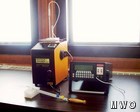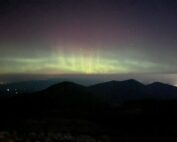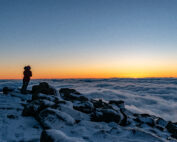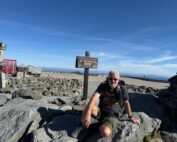Thermometer Calibration 101
2008-04-11 21:12:25.000 – Matthew Morin, Space Grant Intern
Calibration equipment
I recently received an email from someone interested in how I calibrated the sling psychrometer used in the verification process of the ARVP stations. It was later decided that my response to the email would make a good observer comment because it provides an in depth look at how technical weather observation and research can be.
To assure quality data being logged and reported by the seven ARVP sites, I set out to personally verify the data using a calibrated sling psychrometer. On my hike up the Mount Washington Auto Road, I stopped at each ARVP site and used the sling psychrometer to record the dry and wet bulb temperatures. From those and other atmospheric values, the air temperature and relative humidity could be calculated. I later compared the observed temperature and humidity values to what was recorded in the ARVP database for each site. This verification process was just a trial run. A more formal procedure will be created and executed in the near future.
To calibrate the sling psychrometer’s thermometers, I used an Isotech Hyperion dry block bath to create a reference temperature environment for the temperature sensors. In this “bath”, which was actually a metal cylinder with holes, I inserted the two thermometers used in the sling and a temperature probe. The temperature probe was attached to a TTI-7 High-Accuracy PRT and TC thermometer. This was used to accurately determine the exact temperature of the bath as the Hyperion was itself not an accurate temperature sensing unit. Its forte was maintaining a user-defined constant bath temperature.
The calibration test is a series of reference point checks where I would set the bath to, first, -10°C, wait for the block’s temperature to stabilize, and then record the temperature as indicated by each of the sling’s thermometers. I would then note any discrepancies between the TTI-7 probe and each thermometer. The bath’s temperature would then be raised 5°C and the process would be repeated until after the 30°C setting. Then, to assure consistency in the measurements, the entire calibration process was repeated two more times.
After the calibration tests were done, I averaged the corrections for each thermometer and noted the averaged correction in the thermometer log book. Now, when the sling psychrometer is used and the corrections taken into account, the observer will be assured that they are getting accurate, high quality temperature data.
Matthew Morin, Space Grant Intern
From Mountains to More Mountains
From Mountains to More Mountains: This Time with Stronger Winds By Alyssa Bélanger On the observation deck in high winds. Hello there! My name is Alyssa Bélanger and I am a fall
From Summit to Sign-Off: My Farewell to the Rockpile
From Summit to Sign-Off: My Farewell to the Rockpile By Amy Cotter Enjoying my last Mount Washington sunset (for now) on September 13, 2025. After two incredible years with the Mount Washington
Trail Report: Seek the Peak Hikes 16 and 17!
Trail Report: Seek the Peak Hikes 16 and 17! By Chris Nichols September 22, 2025 – Summit 16 of 17 A chilly morning turned into a spectacular day on Mount Washington. The thermostat in






